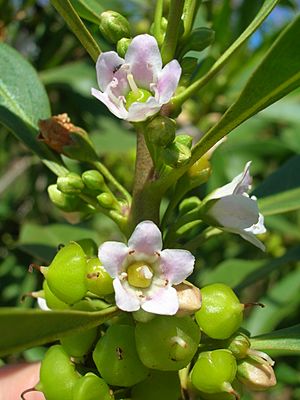Naio facts for kids
Quick facts for kids Naio |
|
|---|---|
 |
|
| Scientific classification | |
| Genus: |
Myoporum
|
| Species: |
sandwicense
|
Myoporum sandwicense, often called naio, is a special kind of flowering plant found only in Hawaiʻi. It belongs to the figwort family, called Scrophulariaceae. This plant can grow in many different ways. It might be a small tree, a large tree, or even a shrub. Its leaves, flowers, and fruits can also look very different depending on where it grows.
Contents
What Naio Looks Like
Naio plants change a lot based on their location and how high up they grow. Some naio are small trees, about 9 meters (30 feet) tall, with a trunk about 0.3 meters (1 foot) wide. The biggest naio trees can reach 18 meters (60 feet) tall, with trunks up to 0.9 meters (3 feet) wide! If you find naio growing very high up, near the tree line, it might be a small shrub only 0.6 meters (2 feet) tall.
Older naio trees often have dark, rough bark with deep grooves. Their leaves grow in a special way, one after another along the stem. They are often grouped together near the ends of the branches. Most leaves are about 60 to 135 millimeters (2.4 to 5.3 inches) long and 11 to 25 millimeters (0.4 to 1 inch) wide. They are shaped like an oval or a spear, and you can see a clear line down the middle on the bottom of the leaf.
Naio Flowers and Fruit
You can find naio flowers all year round! They grow in groups of 2 to 6 where the leaves meet the stem. Each flower has a stalk that is about 4.5 to 18 millimeters (0.2 to 0.7 inches) long. The flowers look like a bell and smell nice. They have 5 pointed sepals (small leaf-like parts that protect the bud) and 5 petals that form a tube. This tube is usually white or pink, with darker spots at the bottom. The tube is about 1.5 to 3.5 millimeters (0.06 to 0.14 inches) long, and the petals are about the same length.
The fruit of the naio plant is a waxy white drupe. A drupe is a fruit with a hard pit inside, like a peach. Naio fruits are about 8 millimeters (0.3 inches) across. They are juicy but taste bitter. Often, the fruits dry out and stay on the branch for a long time.
Naio's Scientific Name
The scientific name Myoporum sandwicense was first officially described in 1866 by a scientist named Asa Gray. He published his description in a science journal. The second part of the name, sandwicense, comes from the "Sandwich Islands." This was the name James Cook gave to the Hawaiian Islands when he explored them. The very first plant used to describe the species was collected there.
There are two main types, or subspecies, of naio:
- Myoporum sandwicense subsp. sandwicense: This type grows on all the Hawaiian Islands. Its fruit is shaped like an oval or is almost perfectly round.
- Myoporum sandwicense subsp. lanaiensis: This type is found only on the island of Lanai. Its fruit is shaped more like a cone or a flat lens.
There is also a special type called naio papa. This is a low, creeping shrub that grows flat along the ground. You can only find naio papa at South Point on the island of Hawaiʻi.
Where Naio Grows
Naio is found only in the state of Hawaiʻi in the United States. You can see it on all the main Hawaiian islands. It grows from sea level all the way up to 2,380 meters (7,800 feet) high!
Naio can live in many different places, like low shrublands, dry forests, and even wet rainforests. However, it is most common in the high shrublands found on mountainsides.
How People Use Naio
Traditional Uses by Native Hawaiians
The wood of the naio tree is very fine and hard. Native Hawaiians called this wood ʻaʻaka. They used it for many important things. They made special curved pieces for the front and back of their waʻa (outrigger canoes). They also used it for the sides of the canoes, for posts to build houses, and for spacers in their fishing nets. Naio wood was also used to make lamalama, which were long-burning torches for night fishing.
Because naio wood has a natural oil and smells similar to ʻiliahi (Santalum spp.), which is sandalwood, Native Hawaiians sometimes used naio as a replacement for sandalwood when they burned it.
Growing Naio Plants
You can grow new naio plants from their seeds. The seeds are taken out of the fruit. It can take a long time for the seeds to sprout, usually between six and eighteen months. You can also grow naio by taking cuttings (parts of the stem) or by a method called air layering, where roots are encouraged to grow on a branch while it's still attached to the main plant.
Other Uses of Naio
In the 1800s, after most of the valuable Hawaiian sandalwood (ʻIliahi) had been cut down, naio was sent to China for a short time. There, it was made into incense and burned in temples called Joss houses.
See also
 In Spanish: Naio para niños
In Spanish: Naio para niños

